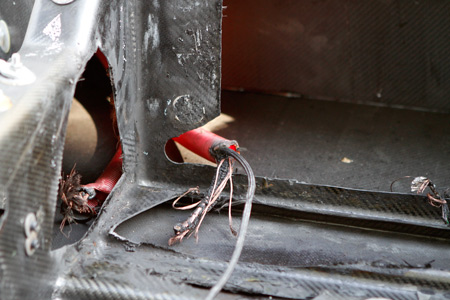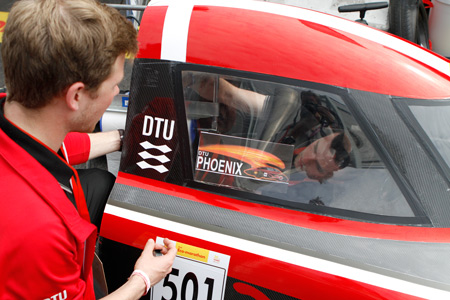|
by Bjørn Lymann Jespersen
In spite of a burned-out engine compartment two days before race start, DTU Roadrunners managed to set a new world record in fuel efficiency at the recent Shell Eco-marathon. The team achieved 665 km/l, beating their own world record from 2013 of 612.7 km/l. The record also meant that the team won their category UrbanConcept—Alternative fuel.
DTU has participated in the Shell Eco-marathon for the past 11 years, where energy-friendly cars built by students compete to get the most mileage out of a litre of petrol. DTU Roadrunners have won their class, UrbanConcept—Alternative fuel for the past four years and 10 out of the 11 times they have been participated.
Therefore, this year's team also was aware that there was a lot to live up to, and had been preparing intensively for many months with several tests of and improvements to the vehicle, which runs on second-generation bioethanol. Among other things, the car got a new automatic gearbox, allowing the driver to focus her attention on keeping track of times and on the track. The compression ratio in the engine has also been increased from 12:1 to 14:1, resulting in higher performance and less fuel consumption.

The burned-out engine compartment at 9 a.m. on Thursday morning.
Burned-out engine compartment
However at 4.00 a.m. on Thursday 21 May, it looked as through DTU Roadrunners would not not manage to get their car out on the track for the Shell Eco-marathon 2015. During the night, an engine compartment caught fire, destroying all electronics and large parts of the carbon fibre shell. Fortunately, none of this year's improvements suffered any damage during the fire.
Before the fire, things had otherwise been looking good for the team. As one of the first, the car had made it through the technical inspection where technicians from Shell check that everything on the car lives up to the competition rules. On Wednesday, the team had made its first test run where they recorded a reasonable result and looked forward to their run the following day. It was therefore a big blow when pit boss Per K. Jensen at 3.30 a.m. was woken by Shell's security staff and learned that their Dynamo car had been on fire.
“Of course I thought about giving up, because it looked really hopeless, but I quickly got my motivation back because giving up is no fun,” says Per K. Jensen. They held a quick meeting and then started rebuilding the car.

New name for a new car
During the next two days, the team worked night and day. The electrical system in particular required complete reconstruction, but the team had great help from the other teams and also had parts and extra staff sent to Rotterdam from Denmark.
The hard work paid off, and as the engine finally started 44 hours after the fire, the team celebrated as if they had won it all. The team also decided to officially rename this year's car from DTU Dynamo to DTU Phoenix, based on the legend of the Phoenix bird which dies and is reborn from its own ashes.
Forward against the wind
On Saturday morning, the car again had to undergo the technical inspection because so much had been replaced due to the fire. However, the inspection was quickly completed, and the team achieved an impressive 557.2 km/l in the first run, which was enough to secure first place.
However, the team was certain that they could get more out of the car and continued making adjustments and improvements, so they were ready for second run at 5 p.m. on Saturday.
As the car rolled into the inspection hall after the race, all team members were very nervous. This was, however, replaced by jubilant scenes and cheers as the driver, Carina Lindahl, revealed the result: 665 km/l. A performance which not only ensured the overall victory, but also shattered DTU's previous world record by 52.7 km/l.
The last race was run on Sunday. A leak in the tank made the team decide not to have the attempt recorded. This was, however, soon forgotten, as DTU Roadrunners jubilantly received the trophy and could call themselves winners of Shell Eco-marathon 2015 and world champions in fuel-efficient driving.
"It has been full speed ahead against the headwind, but it was always a lot of fun. I have never felt really tired, but experienced a boost of energy and joy every time we solved a problem. I am extremely proud of my own and our team performance,” says Per K. Jensen.